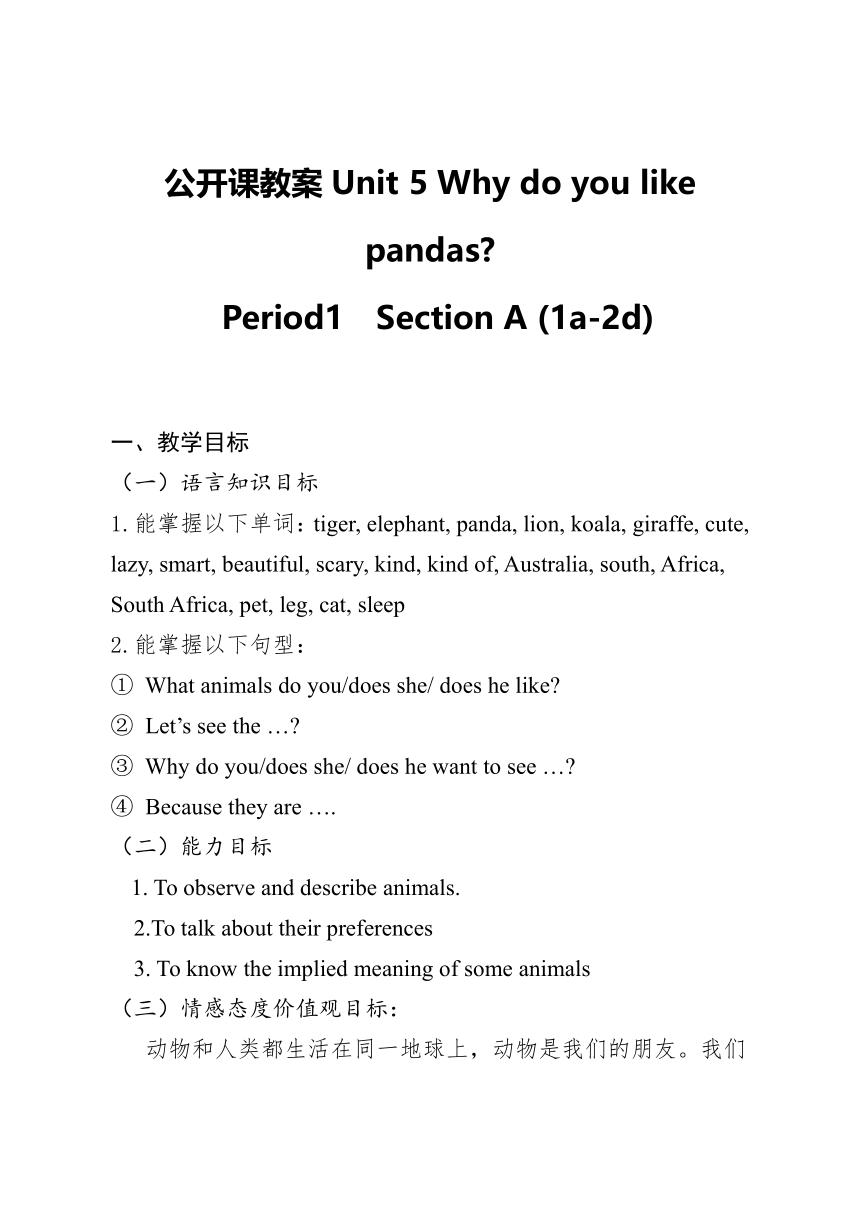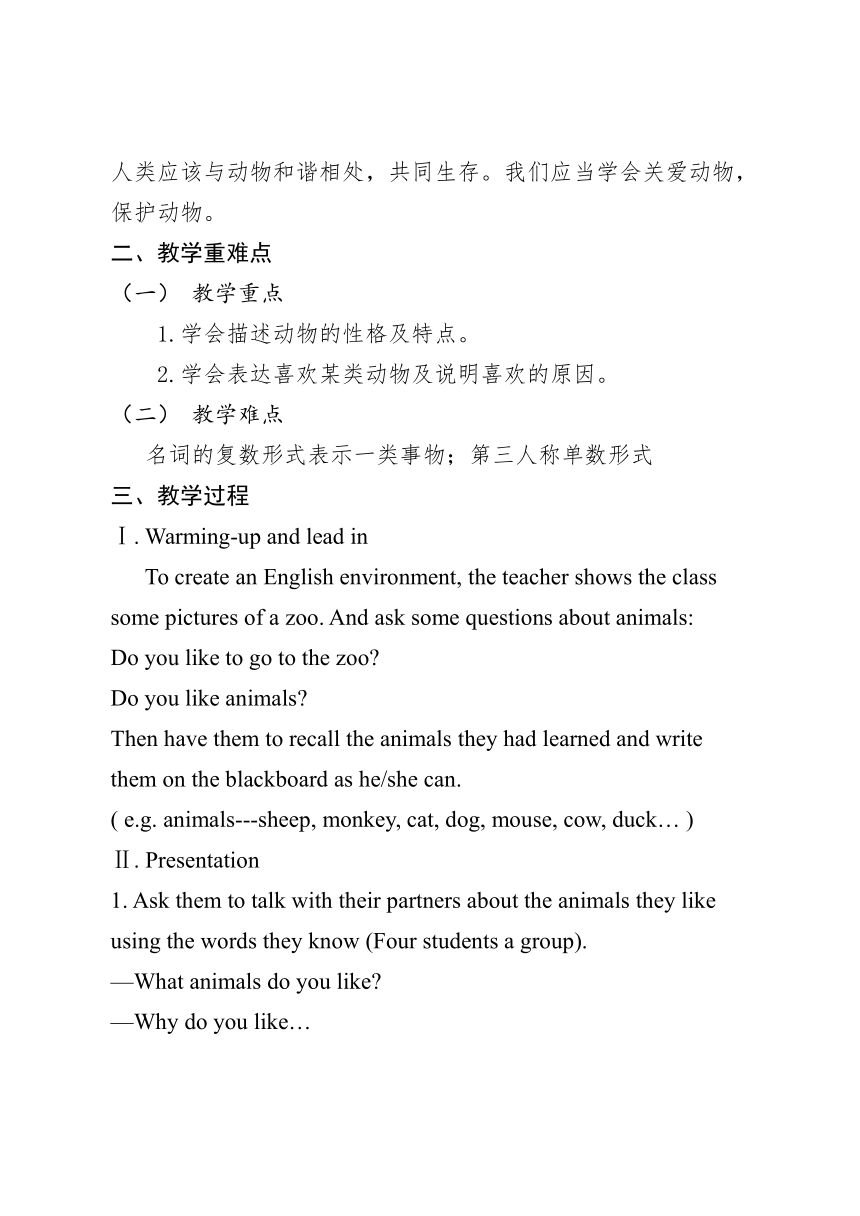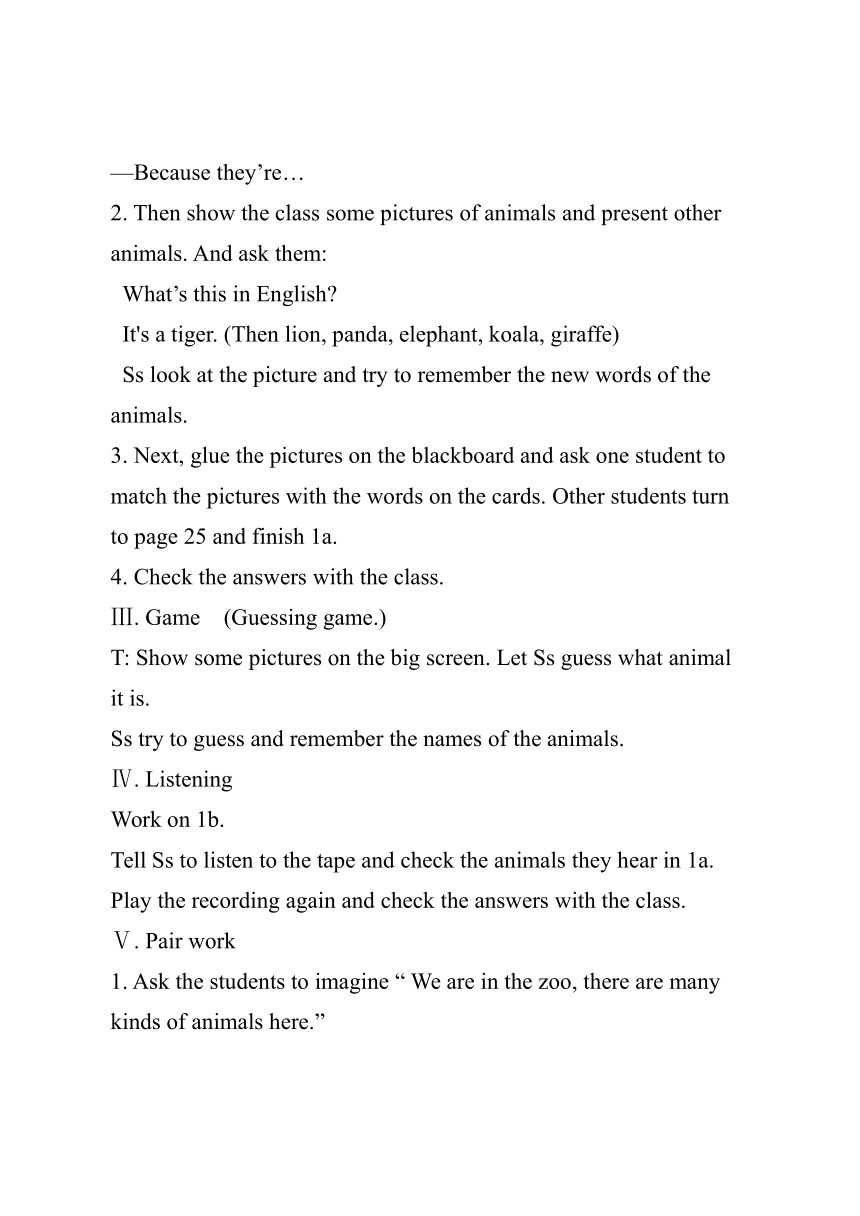Unit 5 Why do you like pandas ?Period 1 Section A (1a-2d)教案
文档属性
| 名称 | Unit 5 Why do you like pandas ?Period 1 Section A (1a-2d)教案 |  | |
| 格式 | doc | ||
| 文件大小 | 34.5KB | ||
| 资源类型 | 教案 | ||
| 版本资源 | 人教新目标(Go for it)版 | ||
| 科目 | 英语 | ||
| 更新时间 | 2022-04-09 19:29:16 | ||
图片预览



文档简介
公开课教案Unit 5 Why do you like pandas
Period1 Section A (1a-2d)
一、教学目标
(一)语言知识目标
1.能掌握以下单词:tiger, elephant, panda, lion, koala, giraffe, cute, lazy, smart, beautiful, scary, kind, kind of, Australia, south, Africa, South Africa, pet, leg, cat, sleep
2.能掌握以下句型:
① What animals do you/does she/ does he like
② Let’s see the …
③ Why do you/does she/ does he want to see …
④ Because they are ….
(二)能力目标
1. To observe and describe animals.
2.To talk about their preferences
3. To know the implied meaning of some animals
(三)情感态度价值观目标:
动物和人类都生活在同一地球上,动物是我们的朋友。我们人类应该与动物和谐相处,共同生存。我们应当学会关爱动物,保护动物。
二、教学重难点
(一) 教学重点
1.学会描述动物的性格及特点。
2.学会表达喜欢某类动物及说明喜欢的原因。
(二) 教学难点
名词的复数形式表示一类事物;第三人称单数形式
三、教学过程
Ⅰ. Warming-up and lead in
To create an English environment, the teacher shows the class some pictures of a zoo. And ask some questions about animals:
Do you like to go to the zoo
Do you like animals
Then have them to recall the animals they had learned and write them on the blackboard as he/she can.
( e.g. animals---sheep, monkey, cat, dog, mouse, cow, duck… )
Ⅱ. Presentation
1. Ask them to talk with their partners about the animals they like using the words they know (Four students a group).
—What animals do you like
—Why do you like…
—Because they’re…
2. Then show the class some pictures of animals and present other animals. And ask them:
What’s this in English
It's a tiger. (Then lion, panda, elephant, koala, giraffe)
Ss look at the picture and try to remember the new words of the animals.
3. Next, glue the pictures on the blackboard and ask one student to match the pictures with the words on the cards. Other students turn to page 25 and finish 1a.
4. Check the answers with the class.
Ⅲ. Game (Guessing game.)
T: Show some pictures on the big screen. Let Ss guess what animal it is.
Ss try to guess and remember the names of the animals.
Ⅳ. Listening
Work on 1b.
Tell Ss to listen to the tape and check the animals they hear in 1a.
Play the recording again and check the answers with the class.
Ⅴ. Pair work
1. Ask the students to imagine “ We are in the zoo, there are many kinds of animals here.”
Then ask a student to do the model with you:
— Let’s see the lions first.
—Why (why do you /does she /does he like lions )
—Because they are interesting.
2. Ss work with their partners practice the conversation using the animal in 1a.
Ⅵ. Listening
1. Work on 2a;
T: Listen to the conversation carefully. Then write the names of the animals you hear on these lines.
Play the recording the first time. Students only listen.
Play the recording a second time. This time students write in the names of the animals.
Check the answers.
Point out the adjectives and countries listed on the right. Ask a student to say the words.
Say, Now I will play the recording again. This time draw a line between each animal and the adjective and countries you hear.
Play the recording and have students match each animal with an adjective and a country.
Correct the answers.
2. Work on 2b
T: Listen again and complete the conversation with the words in 2a.
Play the recording for the Ss to listen and write the answers.
Check the answers with the class.
Ⅶ. Pair work
1. Ask two students to read the conversation in 2b to the class.
2. Ss practice the conversation in pairs.
3. Then show the transcription on the big screen and practice the other two conversations in 2a.
4. Ss practice the conversations in pairs.
Ⅷ. Role-play
1. Ask Ss to look at the picture in 2d. Then Ss read the conversation in 2d and find the answers to the questions:
① Does Peter have a pet
② What can Dingding do
③ What pet does Jenny’s mom have
④ Does Jenny like the cat Why
2. Ss read the conversations and try to find the answers to the questions.
Check the answers:
Yes, he does.
He can walk on two legs. He can dance, too.
She has a cat.
No, she doesn’t. Because it’s very lazy.
3. Ss work in pairs and practice the conversation.
4. Let some pairs role-play the conversation.
IX.Homework:
1. Remember the new words and expressions in this period.
2. Role-play the conversation after class.
3. Write the animal's names as many as possible in the exercises book.
四、板书设计
五、教学反思
本课时Section A 1a的图词搭配,充分调动学生的视觉和发散思维,图文并茂让记忆更加牢固。1b是听力活动,初步呈现了本单元的目标语言。1c是口头练习,学生学习新的形容词,并运用到自己的对话中。2a和2b是两个听力活动,一段相同的材料,从两个不同的角度测试学生听力,激发学生的发散思维。2d是会话活动,要求学生根据可呢么内容中的对话做角色扮演。本节课中,教师引出新句型,并且对此进行训练,以学生喜爱的动物为话题,并运用PPT、声音媒体等手段进行教学,设置练习和实践所需的真实情境,营造良好的语言学习情境。采用情境试听法,小组合作学习,任务型教学法,为学生设置真实情境、语境,使学生在思考、交流、合作探究中学习和使用语言。
教师能顺利完成教学任务,学生收效良好。
Section A (1a-2d)
Drills:
1. —Let's see the lions.
—Why do you want to see them
—Because they're interesting.
2b: elephants, kind of, South Africa
2c: ① Does Peter have a pet
② What can Dingding do
③ What pet does Jenny’s mom have
④ Does Jenny like the cat Why
PAGE
Period1 Section A (1a-2d)
一、教学目标
(一)语言知识目标
1.能掌握以下单词:tiger, elephant, panda, lion, koala, giraffe, cute, lazy, smart, beautiful, scary, kind, kind of, Australia, south, Africa, South Africa, pet, leg, cat, sleep
2.能掌握以下句型:
① What animals do you/does she/ does he like
② Let’s see the …
③ Why do you/does she/ does he want to see …
④ Because they are ….
(二)能力目标
1. To observe and describe animals.
2.To talk about their preferences
3. To know the implied meaning of some animals
(三)情感态度价值观目标:
动物和人类都生活在同一地球上,动物是我们的朋友。我们人类应该与动物和谐相处,共同生存。我们应当学会关爱动物,保护动物。
二、教学重难点
(一) 教学重点
1.学会描述动物的性格及特点。
2.学会表达喜欢某类动物及说明喜欢的原因。
(二) 教学难点
名词的复数形式表示一类事物;第三人称单数形式
三、教学过程
Ⅰ. Warming-up and lead in
To create an English environment, the teacher shows the class some pictures of a zoo. And ask some questions about animals:
Do you like to go to the zoo
Do you like animals
Then have them to recall the animals they had learned and write them on the blackboard as he/she can.
( e.g. animals---sheep, monkey, cat, dog, mouse, cow, duck… )
Ⅱ. Presentation
1. Ask them to talk with their partners about the animals they like using the words they know (Four students a group).
—What animals do you like
—Why do you like…
—Because they’re…
2. Then show the class some pictures of animals and present other animals. And ask them:
What’s this in English
It's a tiger. (Then lion, panda, elephant, koala, giraffe)
Ss look at the picture and try to remember the new words of the animals.
3. Next, glue the pictures on the blackboard and ask one student to match the pictures with the words on the cards. Other students turn to page 25 and finish 1a.
4. Check the answers with the class.
Ⅲ. Game (Guessing game.)
T: Show some pictures on the big screen. Let Ss guess what animal it is.
Ss try to guess and remember the names of the animals.
Ⅳ. Listening
Work on 1b.
Tell Ss to listen to the tape and check the animals they hear in 1a.
Play the recording again and check the answers with the class.
Ⅴ. Pair work
1. Ask the students to imagine “ We are in the zoo, there are many kinds of animals here.”
Then ask a student to do the model with you:
— Let’s see the lions first.
—Why (why do you /does she /does he like lions )
—Because they are interesting.
2. Ss work with their partners practice the conversation using the animal in 1a.
Ⅵ. Listening
1. Work on 2a;
T: Listen to the conversation carefully. Then write the names of the animals you hear on these lines.
Play the recording the first time. Students only listen.
Play the recording a second time. This time students write in the names of the animals.
Check the answers.
Point out the adjectives and countries listed on the right. Ask a student to say the words.
Say, Now I will play the recording again. This time draw a line between each animal and the adjective and countries you hear.
Play the recording and have students match each animal with an adjective and a country.
Correct the answers.
2. Work on 2b
T: Listen again and complete the conversation with the words in 2a.
Play the recording for the Ss to listen and write the answers.
Check the answers with the class.
Ⅶ. Pair work
1. Ask two students to read the conversation in 2b to the class.
2. Ss practice the conversation in pairs.
3. Then show the transcription on the big screen and practice the other two conversations in 2a.
4. Ss practice the conversations in pairs.
Ⅷ. Role-play
1. Ask Ss to look at the picture in 2d. Then Ss read the conversation in 2d and find the answers to the questions:
① Does Peter have a pet
② What can Dingding do
③ What pet does Jenny’s mom have
④ Does Jenny like the cat Why
2. Ss read the conversations and try to find the answers to the questions.
Check the answers:
Yes, he does.
He can walk on two legs. He can dance, too.
She has a cat.
No, she doesn’t. Because it’s very lazy.
3. Ss work in pairs and practice the conversation.
4. Let some pairs role-play the conversation.
IX.Homework:
1. Remember the new words and expressions in this period.
2. Role-play the conversation after class.
3. Write the animal's names as many as possible in the exercises book.
四、板书设计
五、教学反思
本课时Section A 1a的图词搭配,充分调动学生的视觉和发散思维,图文并茂让记忆更加牢固。1b是听力活动,初步呈现了本单元的目标语言。1c是口头练习,学生学习新的形容词,并运用到自己的对话中。2a和2b是两个听力活动,一段相同的材料,从两个不同的角度测试学生听力,激发学生的发散思维。2d是会话活动,要求学生根据可呢么内容中的对话做角色扮演。本节课中,教师引出新句型,并且对此进行训练,以学生喜爱的动物为话题,并运用PPT、声音媒体等手段进行教学,设置练习和实践所需的真实情境,营造良好的语言学习情境。采用情境试听法,小组合作学习,任务型教学法,为学生设置真实情境、语境,使学生在思考、交流、合作探究中学习和使用语言。
教师能顺利完成教学任务,学生收效良好。
Section A (1a-2d)
Drills:
1. —Let's see the lions.
—Why do you want to see them
—Because they're interesting.
2b: elephants, kind of, South Africa
2c: ① Does Peter have a pet
② What can Dingding do
③ What pet does Jenny’s mom have
④ Does Jenny like the cat Why
PAGE
同课章节目录
- Unit 1 Can you play the guitar?
- Section A
- Section B
- Unit 2 What time do you go to school?
- Section A
- Section B
- Unit 3 How do you get to school?
- Section A
- Section B
- Unit 4 Don't eat in class.
- Section A
- Section B
- Unit 5 Why do you like pandas?
- Section A
- Section B
- Unit 6 I'm watching TV.
- Section A
- Section B
- Review of Units 1-6
- Unit 7 It's raining!
- Section A
- Section B
- Unit 8 Is there a post office near here?
- Section A
- Section B
- Unit 9 What does he look like?
- Section A
- Section B
- Unit 10 I'd like some noodles.
- Section A
- Section B
- Unit 11 How was your school trip?
- Section A
- Section B
- Unit 12 What did you do last weekend?
- Section A
- Section B
